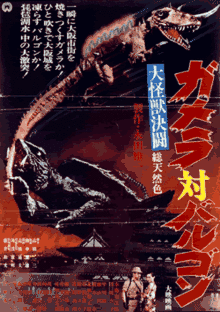Gamera vs. Barugon
| Gamera vs. Barugon | |
|---|---|
 Theatrical release poster | |
| Directed by | Shigeo Tanaka[1] |
| Produced by | Hidemasa Nagata[1] |
| Screenplay by | Nizo Takahashi[1] |
| Starring |
|
| Music by | Chuji Kinoshita[1] |
| Cinematography | Michio Takahashi[1] |
Production company | |
Release date |
|
Running time | 100 minutes[1] |
| Country | Japan |
Gamera vs. Barugon (大怪獣決闘 ガメラ対バルゴン Daikaijū kettō: Gamera tai Barugon) (lit. Great Monster Duel: Gamera vs. Barugon)a is a 1966 Japanese kaiju film directed by Shigeo Tanaka. It is the second entry in the Gamera film series and was released directly to television in the United States by American International Television.[1]
Plot
Set six months after the events of Gamera: The Giant Monster, a meteorite collides with the Z Plan rocket transporting the creature to Mars. Now free, Gamera returns to Earth and destroys Kurobe Dam in Japan. At the same time three mercenaries are sent by Kano, a World War II veteran, to an island in the South Pacific to retrieve a huge opal he once found and hid in a cave. Despite warnings from the local villagers, the trio find and locate the opal, but one dies from a fatal scorpion sting. The second man, Keisuke, Kano's younger brother, is betrayed by his fellow expeditioner Onodera and apparently killed in a cave-in.
En route back to Japan, Onodera accidentally leaves the opal exposed to an infrared light. The heat incubates the opal - actually an egg - and a lizard eventually hatches. Growing to enormous size very quickly, the lizard destroys the ship and Kobe Harbor. Keisuke, having survived the cave-in, awakens in the care of the villagers. He then returns to Japan with a village girl called Karen, who refers to the lizard as Barugon. Barugon wreaks havoc in Osaka with its freeze-gas emitting tongue and stops the launching of the retaliative missiles with a rainbow-like ray emitted from seven spines on the middle of its back. Barugon encounters Gamera and the two battle, with Gamera eventually being frozen solid.
In the meantime, while debating with Kano on how to recover the opal, which he still believes to be aboard the sunken ship, Onodera inadvertently blurts out that he killed his two companions and then murders both Kano and Kano's wife to cover up his crime. After finding Onodera, Keisuke and Karen subdue him and leave him tied up in his home. Keisuke and Karen travel to the Japanese defense ministry and suggest a plan using a huge diamond to lure Barugon into a lake to drown. The plan fails because the diamond's radiation proves to be not enough. Another attempt by irradiating the diamond with additional infrared radiation almost succeeds, until Onodera, having been released and informed of the diamond by his wife, steals the gem. Both he and the diamond, however, are immediately devoured by Barugon.
Keisuke discovers that mirrors are not affected by Barugon's rainbow ray, so the military devises a plan to reflect its own rainbow emanation back at it with a giant mirror. Barugon is wounded by its own ray, but despite prompting it cannot be goaded into repeating its mistake. Gamera thaws out and attacks Barugon once again, and after a destructive battle it drowns Barugon in Lake Biwa, then flies away. Remorseful over the disaster his greed has caused, with his brother now dead, and having found love with Karen, Keisuke decides to make a fresh start on the island where it all began.
Cast
- Kōjirō Hongō as Keisuke Hirata
- Kyōko Enami as Karen
- Yūzō Hayakawa as Kawajiri
- Takuya Fujioka as Dr. Satō
- Kōji Fujiyama as Onodera
- Akira Natsuki as Ichirō Hirata
- Yoshirō Kitahara as Professor Amano
- Ichirō Sugai as Dr. Matsushita
- Bontarō Miake as Self-Defense Force General
- Jutarō Hōjō as Self-Defense Force Commander
- Kazuko Wakamatsu as Sadae Hirata
- Yuka Konno as Onodera's lover
- Eiichi Takamura as Governor of Osaka
- Kenichi Tani as Lee
- Kōichi Itō as Metropolitan Police Superintendent-General
- Hikaru Hoshi as Awaji Maru captain
- Osamu Abe as Awaji Maru crewman
- Yoshihiro Hamaguchi as Awaji Maru crewman
- Teruo Aragaki as Gamera
Production
The film features stock footage from the first Gamera film.[1] Due to the commercial success of Gamera: The Giant Monster, the follow-up, Gamera vs. Barugon, had a expanded budget that Yuasa stated was 80 million yen.[2]
Release
Gamera vs. Barugon was released in Japan on 17 April 1966.[1] The film was never released theatrically in the United States.[1] It was first shown in the United states by American International Television as War of the Monsters with an English-language dub supervised by Salvatore Billitteri.[1] The film was reissued to television and home video by King Features Entertainment in 1987 as Gamera vs. Barugon.[1]
Reception
In a contemporary review, "Chie." of Variety reviewed the film in Tokyo, noting that the special effects int he film were not up to standards of Toho's Eiji Tsuburaya and that Gamera "did not have the winning appeal of the Toho stable "Godzilla", "Radon" [sic], etc.".[3]
Footnotes
References
- Galbraith IV, Stuart (1994). Japanese Science Fiction, Fantasy and Horror Films. McFarland. ISBN 0-89950-853-7.
- Galbraith IV, Stuart (1996). The Japanese Filmography: 1900 through 1994. McFarland. ISBN 0-7864-0032-3.
- Galbraith IV, Stuart (1998). Monsters Are Attacking Tokyo!. McFarland. ISBN 0922915474.
External links
| Wikiquote has quotations related to: Gamera vs. Barugon |
- Gamera vs. Barugon on IMDb
- Gamera vs. Barugon is available for free download at the Internet Archive
- Gamera vs. Barugon at AllMovie
- 大怪獣決闘 ガメラ対バルゴン (Daikaijū kessen: Gamera tai Barugon) at the Japanese Movie Database